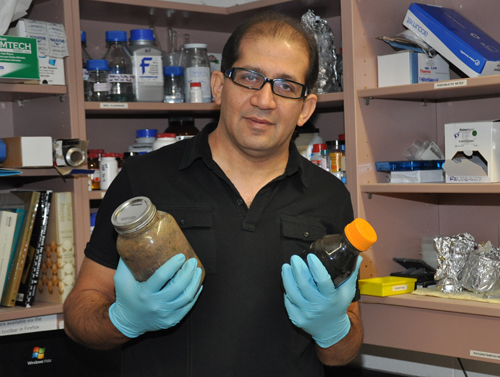
“I’m going to give you the stinky tour,” says Hamid Salsali, adjunct professor in the School of Engineering. At first whiff, his lab in the Thornbrough Building smells like any other – until he opens a bottle of anaerobic bacteria from a wastewater treatment facility. What looks – and smells – like sewage is actually more like black gold: the bacteria can transform organic waste into biogas, a renewable energy source. “It’s fresh,” he says of the bottled bacteria. “I picked it up this morning.”
Salsali is converting one person’s trash into another person’s treasure. He holds up a jar of food waste that looks like porridge, opens it and reaches inside with a gloved finger. “I don’t mind touching it,” he says, pulling out a grape stem. Food scraps that would have ended up in a compost bin or landfill can be converted into biogas simply by adding anaerobic bacteria.
Every type of organic waste – whether it came from animals, plants or humans – has an energy value, says Salsali. That energy is released in a process called anaerobic digestion in which anaerobic bacteria, which live in an oxygen-free environment, convert waste into the two main components of biogas: methane and carbon dioxide.
Holding the jar of food waste, he says the company that provided the sample “has no idea how much energy they can get out of this. I’m going to tell them how much energy is associated with this kind of waste.”
“Waste” isn’t part of Salsali’s vocabulary. “As soon as we’re not using something, people call it waste, and that’s very sad to hear.” He’s on a mission to change people’s perceptions of what they throw away. Visiting local high schools at lunch hour, he collects the students’ food scraps for use in an old-fashioned meat grinder. Thirty minutes after he adds the anaerobic bacteria, the leftover chicken, pasta and sauce turn into biogas – and the students are fascinated.
In the lab, Salsali uses a more technical approach to biogas production: he mixes the anaerobic bacteria with the waste and places the mixture in an incubator at 35 C, the same temperature as an anaerobic digester used on farms. He prefers to work with fresh waste before fermentation begins, which can affect his energy analysis. “Sometimes some of the energy value is already wasted or converted,” he says. “In many cases we are underestimating the energy value.”
Farmers use large-scale anaerobic digesters to break down organic material such as manure, reducing its odour and pathogen levels, and enhancing its nutrient value as a fertilizer. The biogas can be used to generate electricity and heat or as an alternative to natural gas.
Salsali is also working with a local brewery to study the benefits of using rebate beer to maximize biogas production on farms. Rebate beer is considered a waste product because it doesn’t meet the brewery’s quality control standards or has been returned to the store. Since it can’t be resold, it goes back to the brewery, which pays a higher surcharge for its disposal because of its five-per-cent alcohol content.
“What if we mix the rebate beer with the dairy manure to see if we can increase the biogas production?” he says. “We did, and it was a very successful experiment.” The nutrients found in beer increased the manure’s nutrient content, making it a better fertilizer.
Salsali says breweries could save on disposal costs by sending rebate beer to biogas companies.
Says Scott Massen, M.Sc. ’11: “It gives brewers an alternate disposal avenue for getting rid of some waste product, so it’s a mutually beneficial relationship in that respect.” His research as a graduate student with Salsali on rebate beer and biogas production earned him third place at last year’s Rural Green Energy Conference and Exhibition in London, Ont.
Adding rebate beer to dairy manure, he adds, boosts methane production, which can help offset the costs of an anaerobic digester. “When you work with any food industry, it’s a great way to deal with waste and generate some value-added resources from it,” says Massen. “You get the natural gas and you get a better quality compost or fertilizer in the end, too.”
In a joint trial with Carleton University, researchers watered cucumber, eggplant and basil plants with a mixture of beer diluted with water. The plants grew more vigorously, and the vegetables were more flavourful and stayed fresh longer. Beer has similar benefits for livestock. In Japan, says Salsali, farmers give beer to their cattle, resulting in marbleized meat, which is served in high-end restaurants.